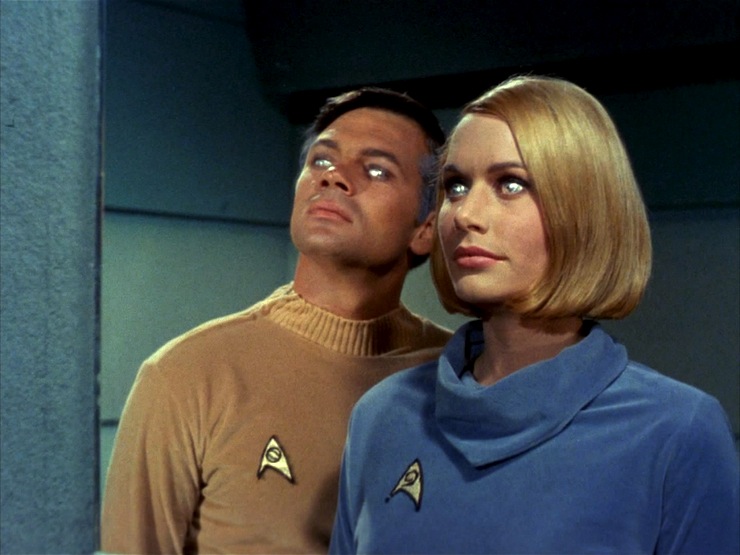“Where No Man Has Gone Before”
Written by Samuel A. Peeples
Directed by James Goldstone
Season 1, Episode 1
Production episode 6149-02
Original air date: September 22, 1966
Stardate: 1312.4
Captain’s log: The Enterprise, en route to the edge of the galaxy, encounters a distress call from the S.S. Valiant, which has been missing for two hundred years. Captain James Kirk and Lieutenant Commander Spock are playing a game of three-dimensional chess, which is interrupted by a call from the bridge. They’ve found the source of the distress call: a small object, only a meter in diameter, which they beam aboard to discover that it’s an old-style beacon that could be ejected when the ship was in trouble. Given how damaged it is when Chief Engineer Montgomery Scott beams it aboard, Spock hypothesizes that the ship was destroyed.
Scotty transmits the data to Spock’s computer and Kirk orders the ship to alert status. Kirk, Spock, and Lieutenant Commander Gary Mitchell take a turbolift to the bridge, and Mitchell also summons department heads to the bridge as they approach the edge of the galaxy. While Kirk gets reports from Scotty, Dr. Mark Piper, Lieutenant Hikaru Sulu, and the new ship’s psychiatrist Dr. Elizabeth Dehner, Spock gets something from the Valiant memory banks. The ship was buffeted about and shot out of the galaxy. The ship came back into the galaxy and the captain was frantically seeking out information in the computer banks about extra-sensory perception—and then the captain gave the order to destroy his own ship.

The fate of the Valiant just makes Kirk more determined to leave the galaxy—other ships need to know what they’re facing.
As they leave the galaxy, they come across a force field of some kind. Sensors don’t read anything, but it’s definitely there. They make contact with the field and then the power starts to drain from the Enterprise. Then consoles start exploding. Kirk orders them to go back, but both Mitchell and Dehner are zapped. Spock takes over the helm and gets them out. They’re on battery power, and nine people have been killed. Dehner is groggy, and Mitchell’s eyes have gone silver.
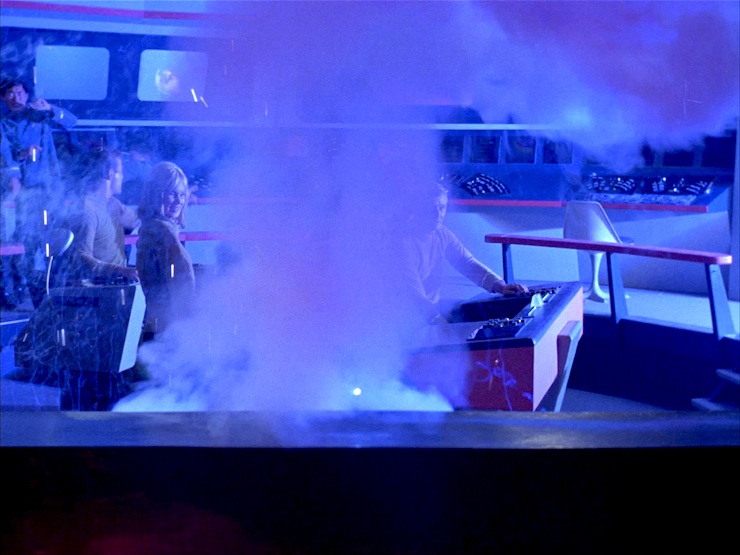
Oddly, the nine people who were killed had higher than normal ESP ratings—Dehner also has a high rating, and Mitchell’s was higher than anyone’s.
Kirk visits Mitchell in sickbay. He seems normal, except for the eyes, but he also describes the philosophers Hume and Spinoza as “childish.” Mitchell is also reading faster and faster. However, Piper finds nothing physically wrong with him. Dehner talks to him, and Mitchell actually changes the lifesign readings on his biobed—Mitchell himself is surprised by it. Dehner also discovers that Mitchell not only reads fast, he remembers everything he’s read. She grabs a tape (!) and picks a page at random, and he quotes the love poem on that page.
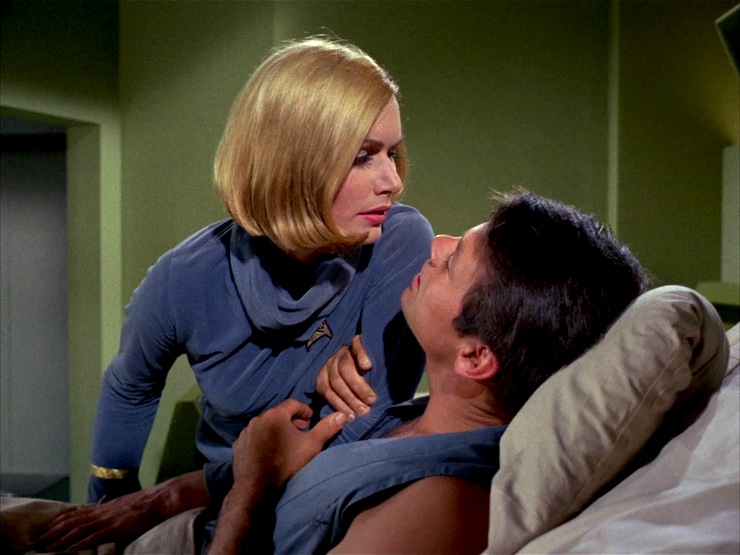
Lieutenant Lee Kelso comes to visit him, and the visit is friendly at first, but then Mitchell warns him that the points are burned out on the impulse packs. After Kelso thumphers and departs, Mitchell tells Dehner that he saw the image of the points in Kelso’s mind, but Kelso himself didn’t notice their condition.
Later, there’s a briefing, with Kirk, Spock, Kelso, Scotty, Piper, Sulu, and Dehner, in which Kelso announces that Mitchell was right about the impulse pack. In addition, Scotty reports that Mitchell has been telekinetically manipulating the bridge controls, and Dehner also reveals his trick with the biobed. Sulu says that Mitchell’s powers are increasing geometrically.
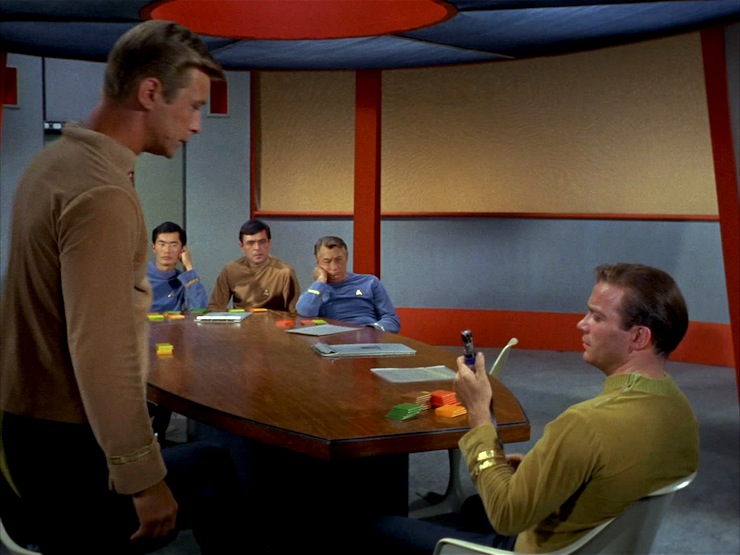
After Kirk ends the meeting, Spock makes his recommendations: that they go to Delta Vega, an automated lithium-cracking station that may have parts they can cannibalize to fix the engines; and that they either strand Mitchell there or kill him outright. Kirk isn’t thrilled about any of this—if they can’t adapt the station’s parts, they’ll be stuck there as they lack the power to blast back out of orbit, and the station only gets ore haulers once every twenty years, so Mitchell will be stuck alone—but he gives the order to set course there.
As they achieve orbit, Kirk, Spock, and Dehner visit Mitchell in sickbay. He knows what they’re planning, and he almost stops them, but they manage to subdue and sedate him. They put him in a cell on the station. (Why an automated station has a cell is left as an exercise for the viewer.) Mitchell tries to walk back some of things he said (like squashing them like insects), but he isn’t very convincing. He reminds everyone that he keeps getting stronger. Kelso, having supervised a full repair of the Enterprise engines, has put together a destruct switch to destroy the station (and Mitchell) if needs be. Unfortunately, Kirk mentions this in front of Mitchell, who then kills Kelso, stuns Kirk and Spock, and deactivates the force field. He leaves Dehner alone—mostly because she now has silver eyes, too.
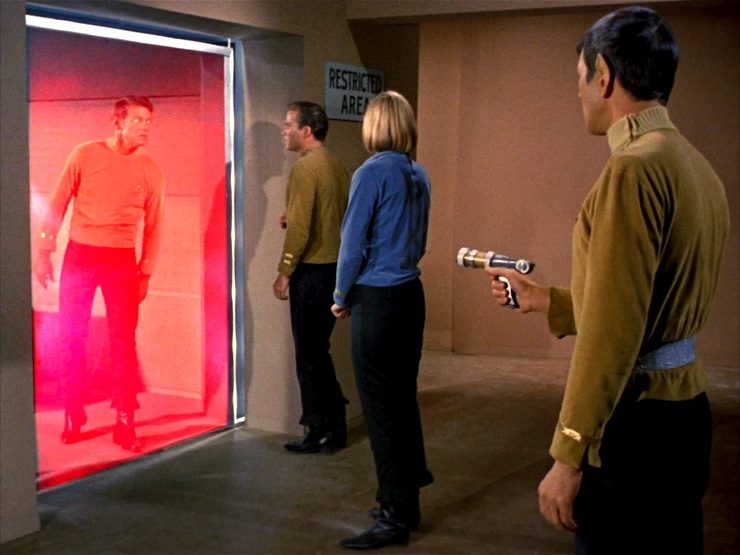
Piper revives Kirk, reporting that Mitchell and Dehner went off into the hills. Kirk orders Piper to revive Spock after he leaves with a phaser rifle, and orders them to beam back to the Enterprise. If Kirk doesn’t come back in twelve hours, they’re to warp away and recommend that the planet be bombarded with neutron radiation.
Mitchell and Dehner create vegetation and water out of nothing. When Kirk seeks them out, Mitchell sends Dehner to talk to him—to see how “unimportant they are.” Kirk tries to convince her to hang onto her humanity. When a grinning Mitchell shows up, he’s unaffected by the phaser rifle’s power. Then he creates a grave for Kirk and is about to start a rockslide, but Dehner tries to get him to stop.

Even as Mitchell toys with Kirk, Kirk tries to get her to see what he’s turned into. Mitchell and Dehner wind up fighting by zapping each other with electricity. Dehner weakens him enough so that Kirk and Mitchell can have a proper fistfight, one in which Kirk’s shirt is torn in a manly manner.
But Kirk can’t quite deliver the killing blow, hesitating just long enough for Mitchell to get his mojo back. Kirk manages to get him into the grave for a second, allowing him to use the phaser rifle to cause the rockslide Mitchell had almost started, burying him alive.
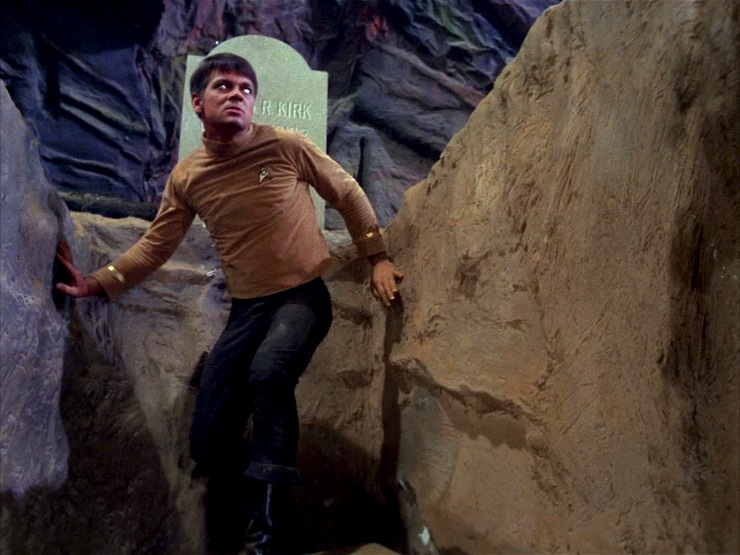
Dehner dies after apologizing for letting the power go to her head. Kirk asks for beam-out, and notes in his log that Dehner and Mitchell died in the line of duty.
Can’t we just reverse the polarity?: We never actually see the engine room, and the only parts that are replaced when Kelso supervises the repairs are on the bridge, which somehow restores warp drive. Specifics of how this stuff is accomplished is danced around. Spock also refers to activating the “sensor beam” to scan the barrier.
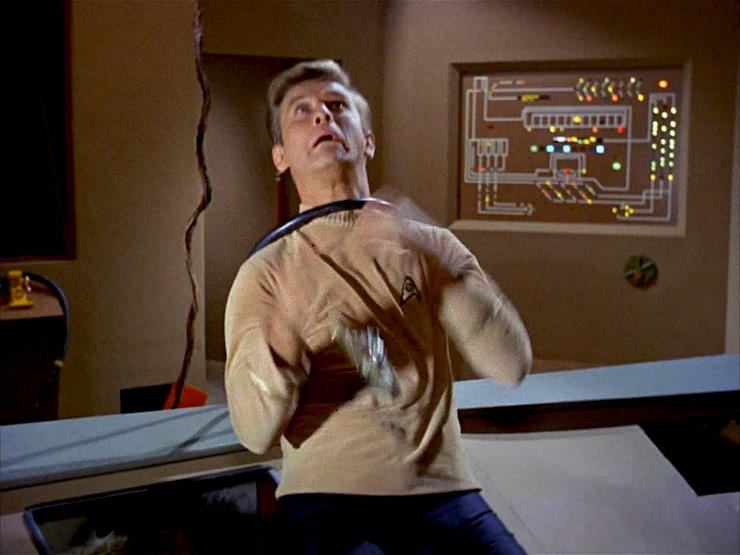
Speaking of the barrier, it’s a ribbon of purple light, which begs the question of why the Enterprise didn’t go over or under it. (The 2007 remastering fixed this issue, making the barrier more three-dimensional.) The notion that it’s visible but undetectable by sensors makes little sense, since humans have been observing stuff outside the galaxy for decades, and we wouldn’t see anything beyond the Milky Way if there was this big purple oval surrounding it. (It would’ve worked if it was the other way around, visible only on sensors but not to the naked eye, but if it wasn’t visible, we couldn’t see it on our TV screens.)
Fascinating: Spock is firmly established as an alien, though not what species. Dehner says people from his planet don’t have feelings “like we do,” and later he himself says that he doesn’t have feelings and is only governed by logic, thus setting the tone for the character going forward. He also comes across as mostly alien, with just one human in the woodpile, referring to “an ancestor of mine” who married a human female. (This can be retconned, given that “Journey to Babel” revealed that Spock and Sarek hadn’t spoken in two decades, to Spock downplaying who it was exactly who married the human…)
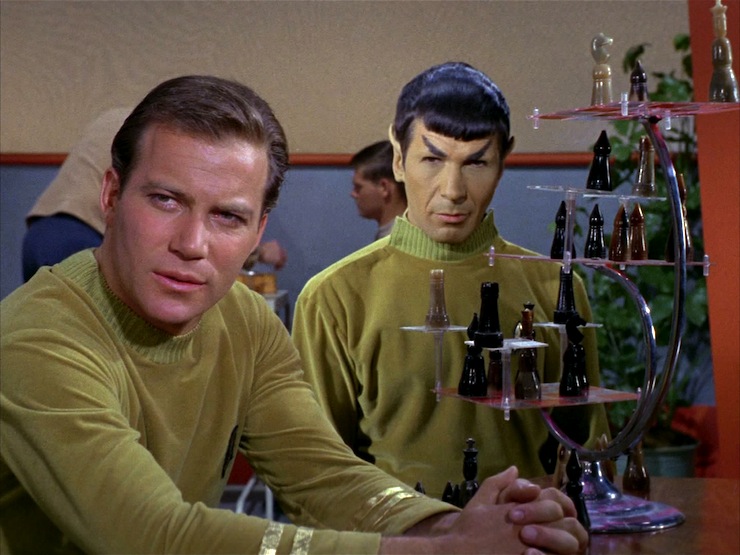
Also we get more shouty Spock! During the entire trip through the galactic barrier, he bellows at the top of his lungs, calling for deflectors to be raised and for a damage report loud enough to rattle the viewscreen. My favorite, though, is the reversal of the stereotypes the characters have embodied over the years: Kirk is the calm one, quietly asking, “Any radiation, anything?” and Spock screaming, “NEGATIVE!” so loud you want to give him a valium or something.
I’m a doctor not an escalator: Piper creates no impression whatsoever. He just looks and acts like an old white guy, without any personality.
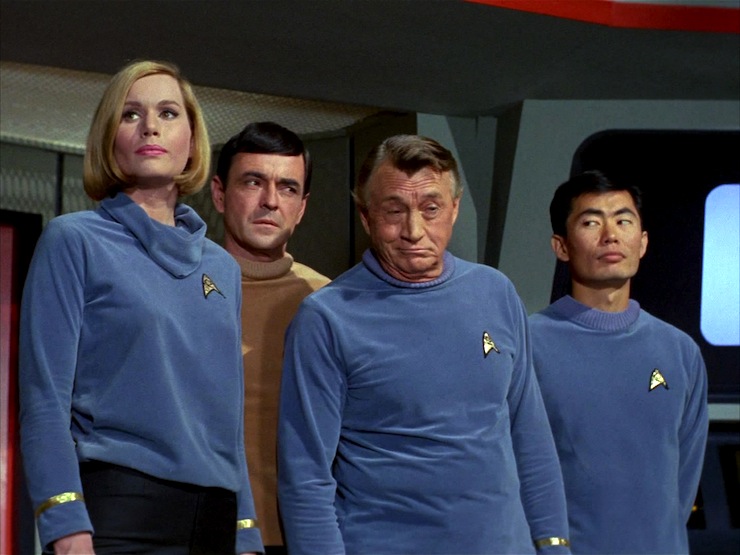
Ahead warp one, aye: Sulu makes his first appearance, but he’s the ship’s physicist, a position never seen or mentioned ever again. The position apparently mostly requires that you explain simple mathematical concepts with even simpler metaphors in briefings with your captain. Flight control seems to be handled by Mitchell.
Hailing frequencies open: Alden is sitting at communications, although the one and only time communications are used, it’s Mitchell who does it, opening up intership.
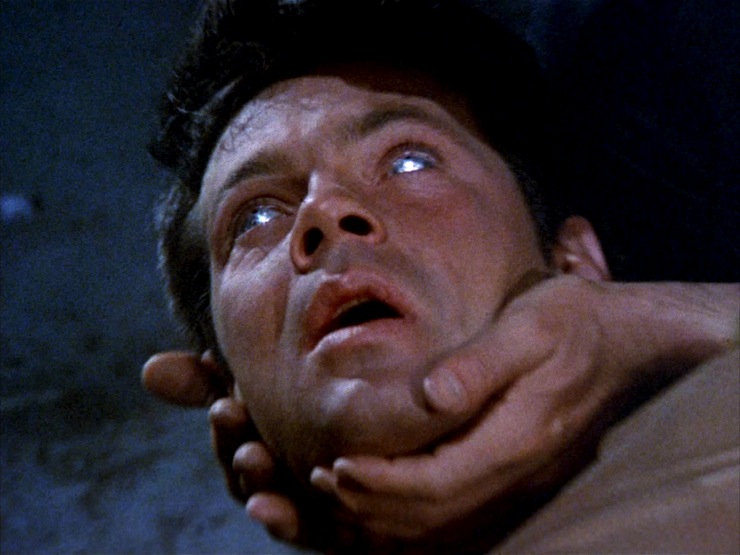
I cannot change the laws of physics!: Scotty runs engineering, though Kelso is the one who seems to be in charge of damage control after the Enterprise gets its ass kicked by the barrier.
Go put on a red shirt: Twelve casualties in this one, nine of whom are never even named or identified or seen or mourned.
No sex, please, we’re Starfleet: Mitchell has a reputation as a flirt, at the very least. Dehner makes a comment about it when they’re introduced, Mitchell holds Smith’s hand when they traverse the barrier, and Mitchell comments to Kirk when he says Dehner will be assigned to observe him, “A hundred women on the ship and that’s the best you can do?”
Mitchell spread the love, though, revealing to Kirk that the “blond lab tech” that the captain almost married at the Academy was a setup by Mitchell himself.
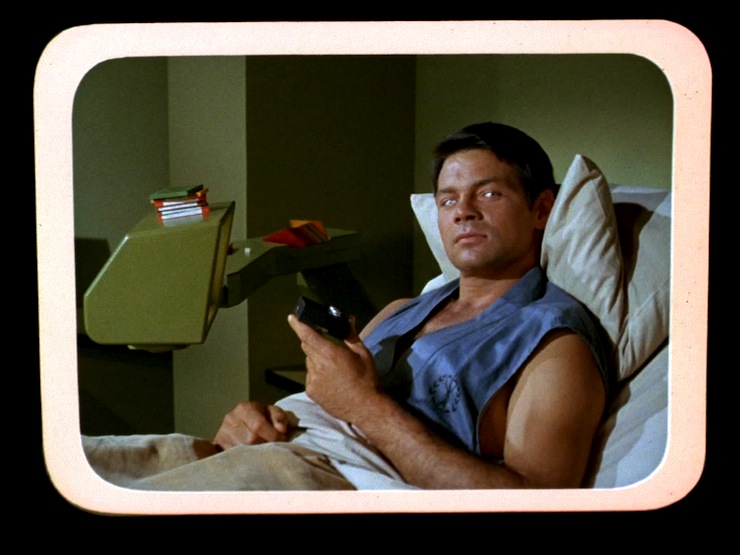
Channel open. “Have I ever mentioned you play an irritating game of chess, Mr. Spock?”
“Irritating? Ah, yes, one of your Earth emotions.”
Kirk and Spock playing 3D chess.
Welcome aboard: This episode marks the first appearance of recurring regulars James Doohan and George Takei as Scotty and Sulu, respectively, while Paul Carr plays Kelso, Paul Fix plays Piper, Lloyd Hanes plays Alden, and Andrea Dromm plays Smith. Fix, Hanes, and Dromm were replaced by DeForest Kelley (whom Gene Roddenberry wanted in the part of the ship’s doctor from the beginning), Nichelle Nichols, and Grace Lee Whitney in “The Corbomite Maneuver.”
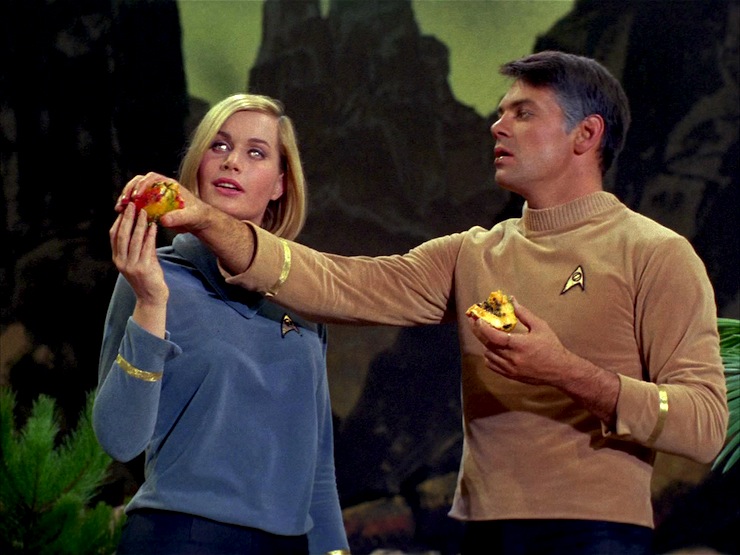
But the big guests are Gary Lockwood (best known as Frank Poole in 2001: A Space Odyssey) as Mitchell and Sally Kellerman (best known as Margaret “Hot Lips” Houlihan in the movie version of MASH) as Dehner.
Trivial matters: The galactic barrier will be seen again twice in “By Any Other Name” and “Is There in Truth no Beauty?”
Kirk’s fake grave is labelled as “James R. Kirk,” while future episodes have “T” as his middle initial, eventually established as standing for “Tiberius” in the animated episode “Bem.” Two different explanations have been provided by tie-in fiction: Peter David had this episode take place in an alternate timeline in which his middle initial was R in the novel Q-Squared, while Michael Jan Friedman made it a running gag between Mitchell and Kirk in the My Brother’s Keeper trilogy, with Kirk joking that his middle name was something beginning with “R” (starting with “racquetball”) so that the gravestone was a private joke between friends.
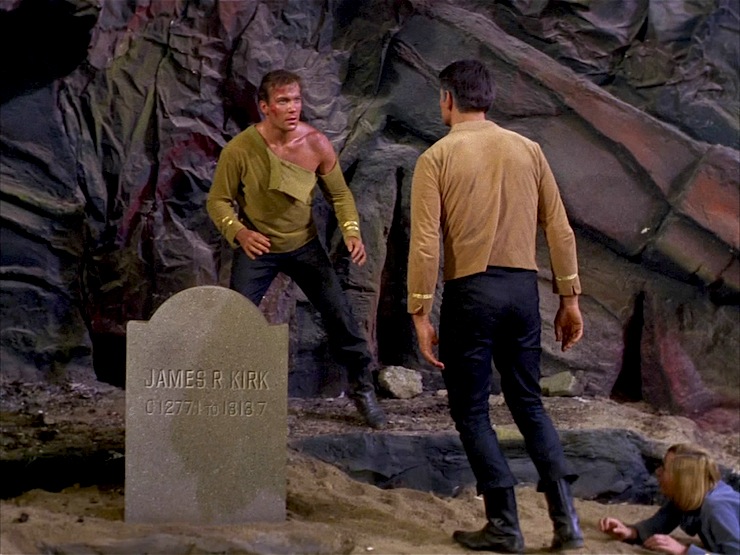
The My Brother’s Keeper trilogy—which was a detailed chronicle of the Kirk-Mitchell friendship prior to this episode—is also one of several novels that show Sulu making the change from physicist to helmsman after this episode, though both Enterprise: The First Adventure by Vonda N. McIntyre and the comic book Star Trek Annual #1 by Mike W. Barr, David Ross, & Bob Smith—which each told the story of Kirk’s first mission as captain of the Enterprise—had Sulu at the helm prior to this episode. Both stories had Leonard McCoy as the chief medical officer for Kirk’s first mission, with the character going on leave and Piper being only a temporary replacement for this episode, and both stories had Uhura at communications as well.
Q-Squared also postulates that the galactic barrier was actually the essence of Q, and he was trying to recorporealize himself through humans, but it only worked on those with high ESP, and was only partially successful, making them crazy. The Q-Continuum trilogy by Greg Cox postulates that the barrier was created by the Q-Continuum to trap a powerful being known only as “0” outside the galaxy.
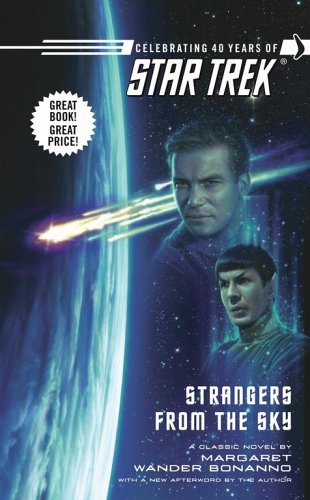
The novel Strangers from the Sky by Margaret Wander Bonanno and the first novella in the Mere Anarchy miniseries, Things Fall Apart by Dayton Ward & Kevin Dilmore, are among the few pieces of tie-in fiction to take place prior to this episode, done with the express purpose of spotlighting Mitchell, Alden, Kelso, and (in the former) Dehner.
The first Vanguard novel, Harbinger by David Mack, takes place immediately after this episode, as the Enterprise encounters Starbase 47, a.k.a. Vanguard, while on the way home from Delta Vega.
“Nightingale Woman” by Tarbolde of the Canopus Planet is referenced several times on Deep Space Nine.
More is learned about the fate of the Valiant by the U.S.S. Stargazer, on the mission during which Jean-Luc Picard becomes her captain, in the novel The Valiant by Michael Jan Friedman.
Allegedly, Andrea Dromm was cast by Gene Roddenberry for the virtually nonexistent part of Yeoman Smith (whose only line was to correct Kirk’s misremembering of her name) in order to score with her. He allegedly failed.
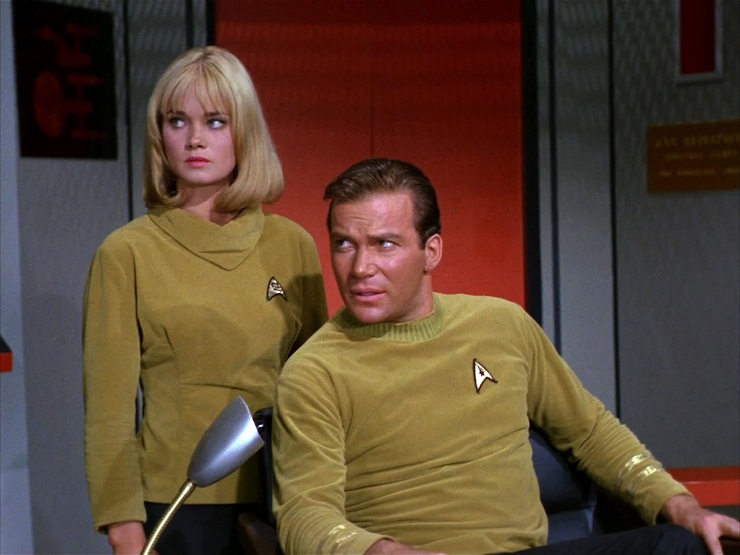
As in “The Cage,” Starfleet’s uniforms only include gold for command and operations and blue for sciences. Though he’s the communications officer and relief helmsman, Alden wears blue. This is the only episode of the series in which Spock wears gold rather than blue. Red will be added in “The Corbomite Maneuver” for security and operations, and Scotty will wear that color moving forward.
It’s unclear who Kirk’s first officer is. Both Spock and Mitchell perform the duties one would expect of a first officer at different times in the episode (Mitchell summoning department heads to the bridge, Spock culling damage control reports and such), and Spock is in command gold rather than science blue (though he’s only verbally identified as Kirk’s science officer). Some tie-in fiction has postulated that it was Spock, others that it was Mitchell. Probably one is first officer and one is second officer, but who’s who is not at all obvious.
While this episode was aired third—because it was too exposition-heavy to air first, supposedly—Roddenberry did take a copy to the World Science Fiction Convention in Cleveland and showed it to a room of 500 people on 4 September 1966.
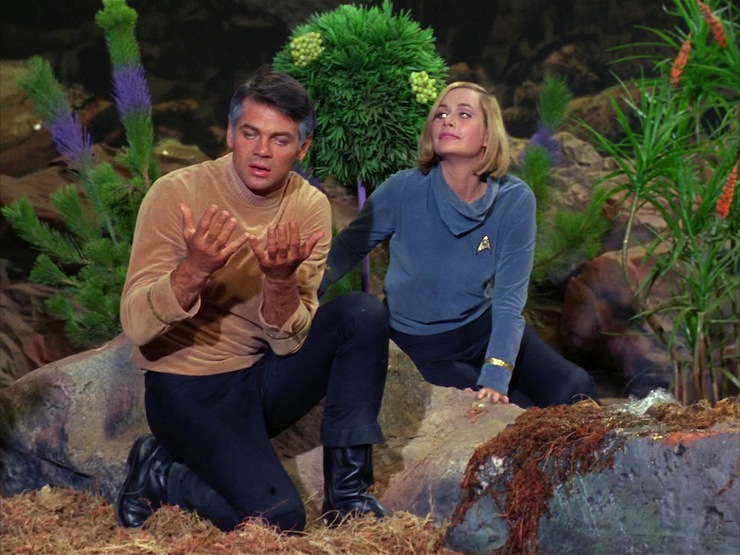
The planet name Delta Vega is reused in the 2009 Star Trek, though it can’t possibly be the same planet, given its location proximate to Vulcan.
When the character of Carol Marcus was introduced in Star Trek II: The Wrath of Khan, there was much fan speculation that she was the “blond lab tech” that Mitchell steered toward Kirk at the Academy, and whom Kirk almost married.
To boldly go: “Morals are for men, not gods.” I’ve always had a soft spot for this episode, partly because there’s something about the look and feel of the Enterprise in this episode (and also “The Cage”) that I actually preferred to the look the series would adopt going forward. I liked the ribbed turtleneck uniforms better than the ones we got, I like that the women actually got to wear pants, and something about the visual design was more appealing to me than the more Technicolor one we got after this.
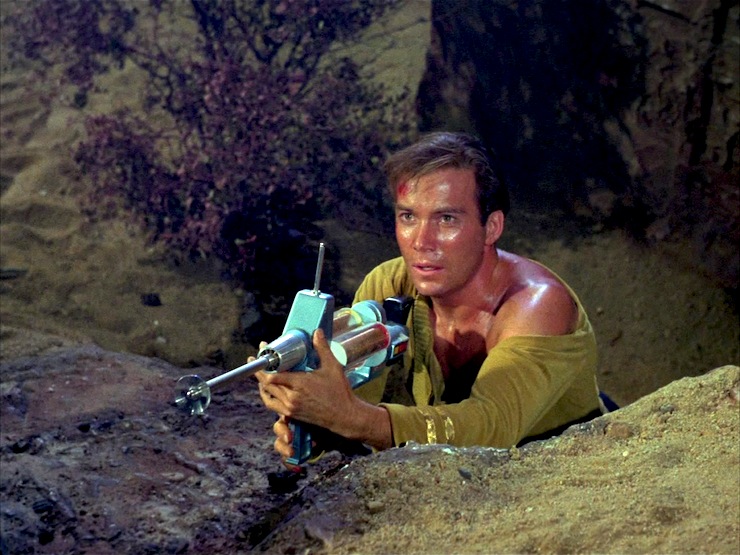
While the mid-1960s executives at NBC no doubt found this more acceptable than “The Cage” because it had a climactic fistfight and a big-ass rockslide and William Shatner rolling around and getting his shirt torn, the main reason why this episode works better than its predecessor is the much more relaxed atmosphere aboard the Enterprise. It’s nothing huge, but these are hundreds of people trapped in a tin can together for months on end. If they’re headed out to the edge of the galaxy, it means they’re very far from home, which is a plot point as their only possible port of call is a planet that’s only visited every two decades.
As a result, we have Kirk and Spock having a friendly game of chess filled with banter, followed by the amusing conversation about the game among the pair of them and Mitchell in the turbolift. We have Mitchell and Smith holding hands. And we have evidence of comfortable friendships between Kirk and Spock, Mitchell and Kelso, Kelso and Scotty, Kirk and Scotty (look at Shatner’s friendly grin at Scotty’s assurance that all is well in engineering when the department heads report), and, of course, Kirk and Mitchell, whose friendship goes back a decade and a half.
That makes what happens later all the more devastating. Little things like Mitchell’s hand-holding of the yeoman and his reminisces with Kirk about their Academy days and his banter with Kelso makes his transformation into a megalomaniac have much more of an emotional consequence.
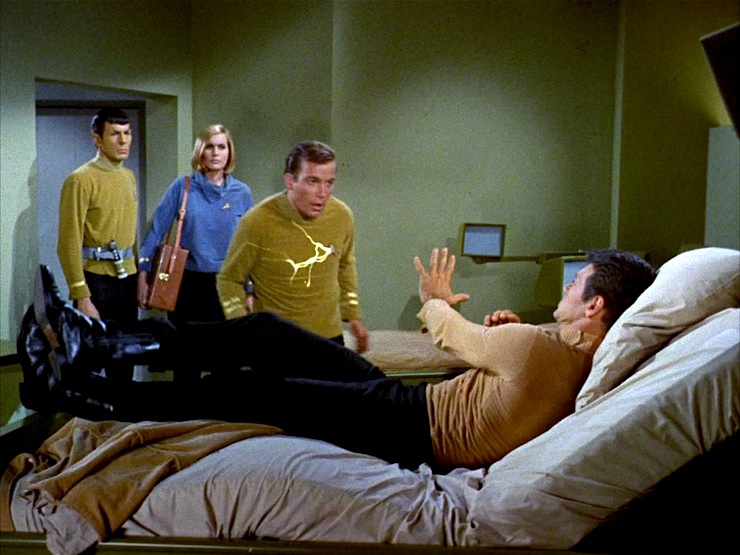
Spock plays devil’s advocate, his alien lack of emotion providing a perspective that Kirk, with his fifteen years of friendship blinding him, and Dehner, with her scientific curiosity doing the same, can’t provide.
The theme of humanity corrupted by such power will continue to be a theme in Roddenberry-era Trek, from “Charlie X” to TNG’s “Hide and Q,” not to mention all the powerful beings who will sit arrogantly in judgment of humans in various episodes from “Errand of Mercy” to “Arena” to “Who Mourns for Adonais” to the Q-Continuum in the various spinoffs to Star Trek V: The Final Frontier. Dehner isn’t wrong that a mutated human can be a good thing, but the evolution is a gradual process and the speed at which Mitchell becomes so powerful is more than any human can handle. And in the end, the only reason Kirk is able to stop him is because Dehner was able to hold onto her humanity long enough to slow Mitchell down.
The conundrum at the heart of the episode is shown by two lines of dialogue. Mitchell says that compassion and command are a fool’s mixture—which is not an invalid point—but Kirk counters later that a god needs compassion—also a valid point, though the religious landscape is filled with gods who wouldn’t know compassion if it bit them on their deific butts. Kirk is reluctant to do what Spock recommends because Mitchell is his friend. Kelso pays the ultimate price for that hesitation, and that’s why Kirk insists on going it alone in the end. Where is the line between command and compassion? Kirk refers to several crew members by their first names throughout, and Spock even is familiar with Kirk in the briefing room. It’s one of the dilemmas of ship command that Trek will also delve into repeatedly, and it gets a strong workout here…
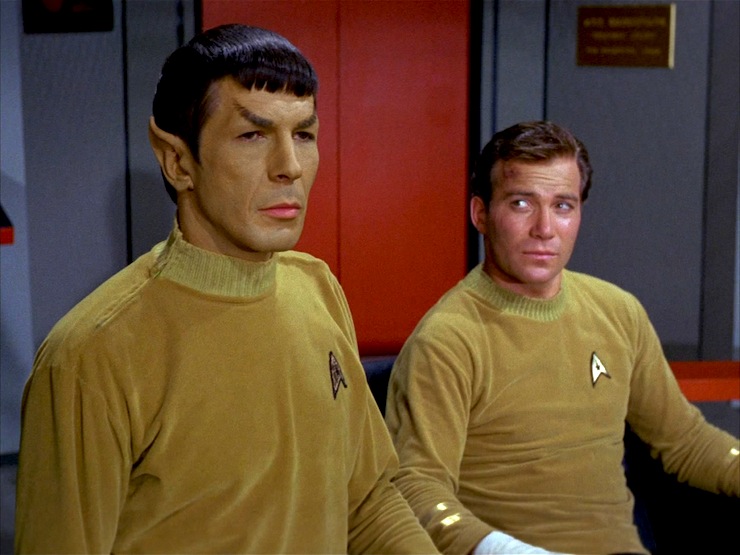
Honestly, my issues with the episode are mostly minor: Piper is a cipher, and would be replaced by someone far more interesting, the notion of a big purple barrier around the galaxy that nobody noticed before remains hilariously ludicrous, and Delta Vega would need to be practically on top of the barrier (in astronomical terms) in order for the Enterprise to get there in as little a couple of days at sublight speeds, which makes the lack of knowledge about the big purple barrier surrounding the galaxy even more ludicrous, since the people who built the lithium-cracking station probably would’ve noticed it.
But the big issue is that we’re supposed to believe that being buried in rocks would stop whatever it was that Gary Mitchell had turned into. Hardly.
Still, this was a good start to what we’d be getting for three years in live action, two years in animation, and bunches of movies. A worthy beginning…
Warp factor rating: 7
Next week: “The Corbomite Maneuver”
Keith R.A. DeCandido’s next two out-of-town public appearances will be at (Re)Generation Who in Hunt Valley, Maryland (along with Doctors Colin Baker, Sylvester McCoy, and, via Skype, Tom Baker, as well as dozens of other Who actors and writers) at the end of March and at Treklanta in Atlanta, Georgia (along with actors Jason Carter, Anne Lockhart, and Sean Kenney, as well as dozens of fan film folk and artists and musicians and performers and such) at the end of April.










